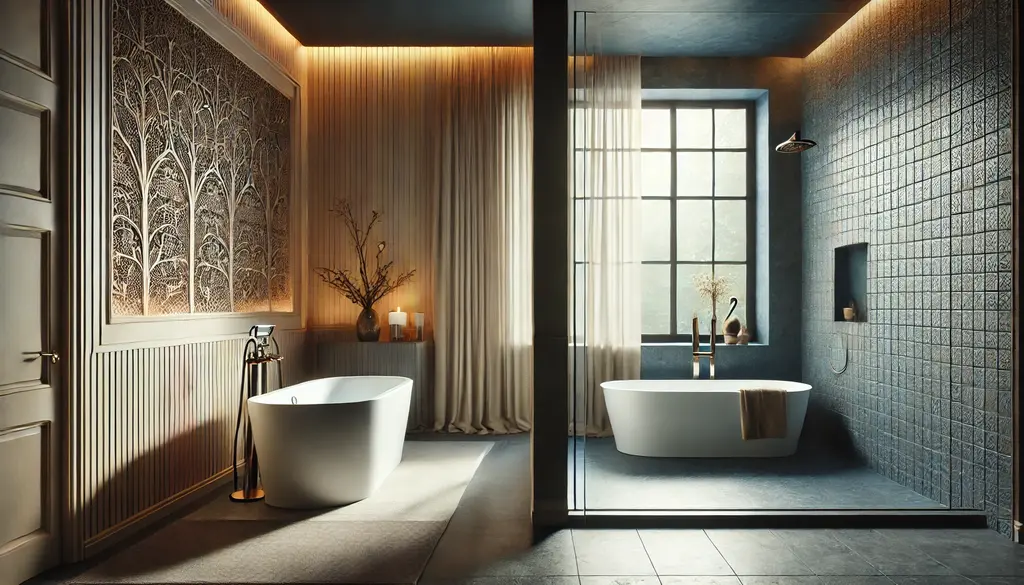When designing or remodeling a bathroom, the bathtub often becomes the centerpiece of the conversation. It’s not just about function; it’s also about aesthetics, comfort, and how the tub complements the overall look and feel of the space.
Choosing between a freestanding bathtub and a built-in bathtub is one of the most significant decisions you’ll make during the process. While both options serve the same purpose, they each bring distinct advantages and considerations.
This short guide will take you through every aspect of freestanding and built-in bathtubs, helping you make an informed choice. Whether aiming for a spa-like sanctuary or optimizing a small space, this article will cover everything you need to know.
What is a Freestanding Bathtub?
A freestanding bathtub is a standalone fixture that does not require attachment to walls or enclosures. Unlike traditional built-in bathtubs installed within a framework, freestanding tubs sit directly on the bathroom floor and are often considered the hallmark of luxury.
Freestanding bathtubs are highly versatile in design. From vintage clawfoot styles that evoke a sense of classic elegance to sleek, minimalist tubs that scream modern sophistication, freestanding tubs are available in countless designs. These tubs are made from materials like acrylic, cast iron, stone resin, and even copper, each offering unique textures and visual appeal.
Freestanding bathtubs can be placed virtually anywhere in the bathroom, provided there’s proper plumbing. They’re ideal for those who want their bathtub to be a statement piece rather than just a functional fixture.
Pros of Freestanding Bathtubs
Freestanding bathtubs are celebrated for their aesthetic appeal and versatility. Here’s a closer look at their many benefits:
- Visual Impact: Freestanding tubs are showstoppers. Whether positioned under a window, in the middle of the room, or against a feature wall, these tubs instantly elevate the bathroom’s design. They serve as a focal point, often making the space feel more luxurious and inviting.
- Design Flexibility: Freestanding tubs can be placed virtually anywhere. Unlike built-in tubs, which are constrained by walls or corners, freestanding tubs allow for greater creativity in bathroom layouts. This makes them particularly appealing for larger bathrooms where space isn’t a constraint.
- Variety of Styles: From timeless clawfoot designs to contemporary freestanding tubs with clean lines, there’s a freestanding tub to suit every taste and bathroom aesthetic. You can choose from an array of materials, shapes, and sizes to match your design vision.
- Easier Installation: Installing a freestanding tub is generally simpler than installing a built-in tub. There’s no need for surrounding walls or a custom-built deck. However, proper plumbing and potentially reinforcing the floor for heavy tubs are necessary considerations.
- Enhanced Spa-Like Experience: Freestanding bathtubs exude a sense of luxury that instantly transforms the bathroom into a personal spa. Their open design often makes them feel more relaxed and inviting.
Cons of Freestanding Bathtubs
Despite their many advantages, freestanding tubs come with some drawbacks that you’ll need to consider:
- Higher Cost: Freestanding tubs tend to be more expensive than built-in models. The cost includes not just the tub itself but also the additional plumbing work and possible structural reinforcements for heavy tubs.
- Space Requirements: Freestanding tubs often require more room to shine. If your bathroom is small, fitting a freestanding tub might make the space feel cramped and reduce its usability.
- Difficult to Clean: Cleaning around and behind a freestanding tub can be tricky, especially if it’s placed near a wall or in a hard-to-reach area. This can lead to dust and grime buildup in areas that are not easily accessible.
- Heat Retention: Some freestanding tubs, especially those made from certain materials, may not retain heat as well as built-in options. This can result in water cooling faster during long soaks.
What is a Built-in Bathtub?
A built-in bathtub, as the name suggests, is installed flush against walls or within a custom-built enclosure. These tubs are highly practical and are often the go-to choice for bathrooms with limited space. Built-in tubs come in several configurations, including alcove tubs (enclosed on three sides) and drop-in tubs (installed into a pre-built deck).
Unlike freestanding tubs, built-in bathtubs are designed to blend seamlessly into the bathroom layout. They can be outfitted with tiled surrounds, storage shelves, or shower combinations, making them an excellent choice for functionality-focused homeowners.
Pros of Built-in Bathtubs
Built-in bathtubs are a practical choice for many homeowners. Here are their key advantages:
- Space Efficiency: Built-in tubs are perfect for smaller bathrooms. They can be tucked into a corner or along a wall, maximizing the available space for other fixtures like sinks, toilets, or storage.
- Affordability: Built-in bathtubs are generally more affordable than freestanding tubs. The overall cost, including installation, is typically lower due to their simpler plumbing requirements and integrated design.
- Integrated Features: Built-in tubs often come with added features, such as storage shelves or built-in shower options. This makes them highly functional, especially for families who need a tub-shower combination for children or multiple users.
- Easier to Clean: The flush design of built-in tubs means there are fewer gaps or hard-to-reach spaces where dirt and grime can accumulate. Cleaning is often more straightforward compared to freestanding models.
- Durability and Heat Retention: Many built-in tubs are designed with materials that offer better heat retention, keeping your bathwater warmer for longer periods. Additionally, their enclosed design provides added stability and durability.
Cons of Built-in Bathtubs
While built-in bathtubs offer practicality, they come with limitations that may not suit every homeowner:
- Limited Design Flexibility: Built-in tubs need to be installed against walls or within a framework, which limits their placement options. This lack of flexibility can make them less appealing for unique or unconventional bathroom layouts.
- Complex Installation: Installing a built-in bathtub often involves more work, including building an enclosure, tiling, and additional plumbing. This can make the installation process more time-consuming and labor-intensive.
- Less Aesthetic Impact: While built-in tubs are functional, they lack the dramatic visual appeal of freestanding tubs. They’re more likely to blend into the bathroom rather than stand out as a statement piece.
- Remodeling Challenges: If you ever decide to replace or remodel a built-in tub, it can be a complex and costly process due to its integrated design.
Freestanding vs. Built-in Bathtubs: A Comparative Analysis
Deciding between a freestanding and built-in bathtub requires a thorough comparison of several factors:
Design and Aesthetics
Freestanding tubs are unmatched in their ability to create a stunning visual impact. They’re perfect for homeowners looking to make their bathtub the centerpiece of the bathroom. Built-in tubs, while less dramatic, offer a sleek and seamless look that integrates well into most designs.
Functionality
Built-in tubs are often more practical, especially for families or small bathrooms. They offer space-saving designs and the ability to combine a shower, making them highly versatile. Freestanding tubs, on the other hand, are more about luxury and relaxation.
Cost Considerations
Freestanding tubs are typically more expensive in terms of the tub itself and the installation requirements. Built-in tubs are a more budget-friendly option, making them ideal for cost-conscious homeowners.
Space and Layout
If you have a spacious bathroom, a freestanding tub can serve as a dramatic focal point. In smaller bathrooms, built-in tubs are often the better choice due to their efficient use of space.
Factors to Consider When Choosing Your Bathtub
When deciding between a freestanding and built-in bathtub, consider the following:
- Bathroom Size: If you have limited space, a built-in tub is likely the better option. Freestanding tubs require more room to be properly showcased.
- Budget: Freestanding tubs are luxurious but come with a higher price tag. Built-in tubs are more affordable and may include additional features like storage or shower combinations.
- Aesthetic Preferences: If design and style are your top priorities, a freestanding tub is the way to go. For those who prioritize practicality, a built-in tub might be the better fit.
- Lifestyle Needs: Families with young children or elderly members might find built-in tubs more practical due to their stability and shower combination options.
Conclusion
Both freestanding and built-in bathtubs have their unique advantages and challenges. The choice ultimately depends on your bathroom’s size, your budget, and your design preferences. Freestanding tubs are ideal for creating a luxurious and eye-catching space, while built-in tubs offer functionality and efficiency.
Take the time to assess your specific needs and envision how your chosen tub will fit into your bathroom design. Whether you’re soaking in a freestanding tub under a chandelier or enjoying the practicality of a built-in model, the right bathtub can elevate your bathing experience and transform your bathroom into a space of relaxation and style.

